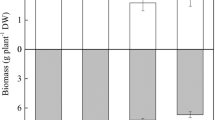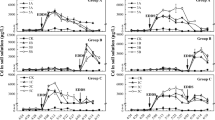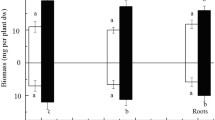Abstract
Purpose
Chelate-assisted phytoremediation with biodegradable chelates has been considered to be a promising technique to enhance phytoremediation efficiency, while little information is available on phytostabilization. This study aims to assess NTA-assisted phytostabilization of Pb-contaminated soils by Athyrium wardii (Hook.).
Materials and methods
A pot experiment was carried out to investigate the effects of different application days (1, 3, 5, 7, 10, 14, 21) of nitrilotriacetic acid (NTA) on plant growth, Pb accumulation, and Pb availability in rhizosphere soils of A. wardii grown in soils contaminated with low (200 mg kg−1) and high (800 mg kg−1) concentrations of Pb.
Results and discussion
With the application of NTA, better growth for A. wardii was observed when treated with NTA for 5–14 days for both low and high Pb soils, suggesting potential harvest time. Pb concentrations and Pb accumulation in underground parts of A. wardii grown in low and high Pb soils increased with increasing application time of NTA generally. Similar changes were also found for bioaccumulation coefficients (BCFs) of A. wardii. The greatest remediation factors (RFs) for underground parts and whole plant of A. wardii were observed for NTA application time of 7 and 5 days for low and high Pb soils, suggesting the greatest remediation efficiency. Furthermore, plant growth, BCF, and RF of A. wardii grown in low Pb-contaminated soils were greater than those grown in high Pb-contaminated soils. Pb availability in rhizosphere soils of A. wardii grown in low Pb soils was lower than those in high Pb-contaminated soils.
Conclusions
It seems to be the optimum for A. wardii to phytostabilize slightly Pb-contaminated soils with the application of NTA for 7 days as taking plant growth, Pb remediation efficiency, and environmental risk into consideration.




Similar content being viewed by others
References
Babaeian E, Homaee M, Rahnemaie R (2016) Chelate-enhanced phytoextraction and phytostabilization of lead-contaminated soils by carrot (Daucus carota). Arch Agron Soil Sci 62:339–358
Bolan NS, Park JH, Robinson B, Naidu R, Huh KY (2011) Phytostabilization: a green approach to contaminant. In: Paul MB, Kate MS, Ronald LP, Larry PW (eds) Advances in agronomy. Elsevier, Amsterdam, pp 145–204
Chiu KK, Ye ZH, Wong MH (2005) Enhanced uptake of as, Zn, and cu by Vetiveria zizanioides and Zea mays using chelating agents. Chemosphere 60:1365–1375
Evangelou MWH, Ebel M, Schaeffer A (2007) Chelate assisted phytoextraction of heavy metals from soil. Effect, mechanism, toxicity, and fate of chelating agents. Chemosphere 68:0989–1003
Freitas EVS, do Nascimento CWA (2009) The use of NTA for lead phytoextraction from soil from a battery recycling site. J Hazard Mater 171:833–837
Gutiérrez M, Mickus K, Camacho LM (2016) Abandoned Pb-Zn mining wastes and their mobility as proxy to toxicity: a review. Sci Total Environ 565:392–400
Hseu ZY, Jien SH, Wang SH, Deng HW (2013) Using EDDS and NTA for enhanced phytoextraction of cd by water spinach. J Environ Manag 117:58–64
Hu XX, Liu XY, Zhang XY, Cao LY, Chen J, Yu H (2017) Increased accumulation of Pb and cd from contaminated soil with Scirpus triqueter by the combined application of NTA and APG. Chemosphere 188:397–402
Huang JW, Chen J, And WRB, Cunningham SD (1997) Phytoremediation of lead-contaminated coils: role of synthetic chelates in lead phytoextraction. Environ Sci Technol 31:800–805
Johnson AW, Gutiérrez M, Gouzie D, McAliley LR (2016) State of remediation and metal toxicity in the tri-state Mining District, USA. Chemosphere 144:1132–1141
Lan JC, Zhang SR, Lin HC, Li T, Xu XX, Li Y, Jia YX, Gong GS (2013) Efficiency of biodegradable EDDS, NTA and APAM on enhancing the phytoextraction of cadmium by Siegesbeckia orientalis L. grown in cd-contaminated soils. Chemosphere 91:1362–1367
Li ZY, Ma ZW, Kuijp TJVD, Yuan ZW, Huang L (2014) A review of soil heavy metal pollution from mines in China: pollution and health risk assessment. Sci Total Environ 468-469:843–853
Luo J, Cai LM, Qi SH, Wu J, Gu XWS (2017) Improvement effects of cytokinin on EDTA assisted phytoremediation and the associated environmental risks. Chemosphere 185:386–393
Margesin R, Schinner F (2005) Manual of soil analysis—monitoring and assessing soil bioremediation. J Chem Phys 90:47–96
Mariet AL, Sarret G, Bégeot C, Walter-Simonnet AV, Gimbert F (2017) Lead highly available in soils centuries after metallurgical activities. J Environ Qual 46:1236–1242
Marx SK, Rashid S, Stromsoe N (2016) Global-scale patterns in anthropogenic Pb contamination reconstructed from natural archives. Environ Pollut 213:283–298
Mendez MO, Maier RM (2008) Phytostabilization of mine tailings in arid and semiarid environments-an emerging remediation technology. Environ Health Perspect 116:278–283
Pourrut B, Shahid M, Dumat C, Winterton P, Pinelli E (2011) Lead uptake, toxicity, and detoxification in plants. In: Whitacre D (ed) Reviews of Environmental Contamination & Toxicology (continuation of residue reviews). Springer, New York, pp 113–131
Qiao JB, Sun HM, Luo XH, Zhang W, Mathews S, Yin XQ (2017) EDTA-assisted leaching of Pb and cd from contaminated soil. Chemosphere 167:422–428
Quartacci MF, Baker AJM, Navari-Izzo F (2005) Nitrilotriacetate- and citric acid-assisted phytoextraction of cadmium by Indian mustard (Brassica juncea (L.) Czernj, Brassicaceae). Chemosphere 59:1249–1255
Quartacci MF, Irtelli B, Baker AJM, Navari-Izzo F (2007) The use of NTA and EDDS for enhanced phytoextraction of metals from a multiply contaminated soil by Brassica carinata. Chemosphere 68:1920–1928
Saifullah Shahid M, Zia-Ur-Rehman M, Sabir M, Ahmad HR (2015) Phytoremediation of Pb-contaminated soils using synthetic chelates. In: Khalid RH, Muhanmmad S, Münir Ö, Ahmet RM (eds) Soil remediation and plants. Elsevier, Amsterdam, pp 397–414
Sarwar N, Imran M, Shaheen MR, Ishaque W, Kamran MA, Rehim A, Hussain S (2017) Phytoremediation strategies for soils contaminated with heavy metals: modifications and future perspectives. Chemosphere 171:710–721
Shahid M, Pinelli E, Dumat C (2012) Review of Pb availability and toxicity to plants in relation with metal speciation; role of synthetic and natural organic ligands. J Hazard Mater 219–220:1–12
Udovic M, Lestan D (2009) Pb, Zn and cd mobility, availability and fractionation in aged soil remediated by EDTA leaching. Chemosphere 74:1367–1373
Usman ARA, Almaroai YA, Ahmad M, Vithanage M, Ok YS (2013) Toxicity of synthetic chelators and metal availability in poultry manure amended cd, Pb and as contaminated agricultural soil. J Hazard Mater 262:1022–1030
Wang X, Wang Y, Mahmood Q, Islam E, Jin XF, Li TQ, Yang XE, Liu D (2009) The effect of EDDS addition on the phytoextraction efficiency from Pb contaminated soil by Sedum alfredii Hance. J Hazard Mater 168:530–535
Wenger K, Gupta SK, Schulin R (2008) Chapter 28 the value of nitrilotriacetate in chelate-assisted phytoremediation. Dev Soil Sci 32:679–695
Yan DYS, Yip TCM, Yui MMT, Tsang DCW, Loa IMC (2010) Influence of EDDS-to-metal molar ratio, solution pH, and soil-to-solution ratio on metal extraction under EDDS deficiency. J Hazard Mater 178:890–894
Yip TCM, Tsang DCW, Lo IMC (2010) Interactions of chelating agents with Pb-goethite at the solid-liquid interface: Pb extraction and re-adsorption. Chemosphere 81:415–421
Zaier H, Ghnaya T, Rejeb KB, Lakhdar A, Rejeb S, Jemal F (2010) Effects of EDTA on phytoextraction of heavy metals (Zn, Mn and Pb) from sludge-amended soil with Brassica napus. Bioresource Technol 101:3978–3983
Zhan J, Li TX, Yu HY, Zhang XZ, Zhao L (2016) The influence of humic substance on cd accumulation of phytostabilizer Athyrium wardii (hook.) grown in cd-contaminated soils. Environ Sci Pollut Res 23:18524–18532
Zhang SJ, Li TX, Zhang XZ, Yu HY, Zheng ZC, Wang YD, Hao XQ, Pu Y (2014) Changes in pH, dissolved organic matter and cd species in the rhizosphere soils of cd phytostabilizer Athyrium wardii (hook.) Makino involved in cd tolerance and accumulation. Environ Sci Pollut Res 21:4605–4613
Zhang HZ, Guo QJ, Yang JX, Ma J, Chen G, Chen TB, Zhu GX, Wang J, Zhang GX, Wang X, Shao CY (2016) Comparison of chelates for enhancing Ricinus communis L. phytoremediation of cd and Pb contaminated soil. Ecotoxicol Environ Saf 133:57–62
Zhao S, Lian F, Duo L (2011) EDTA-assisted phytoextraction of heavy metals by turfgrass from municipal solid waste compost using permeable barriers and associated potential leaching risk. Bioresour Technol 102:621–626
Zhao SL, Jia L, Duo L (2013) The use of a biodegradable chelator for enhanced phytoextraction of heavy metals by Festuca arundinacea from municipal solid waste compost and associated heavy metal leaching. Bioresour Technol 129:249–255
Zhao L, Li TX, Zhang XZ, Chen GD, Zheng ZC, Yu HY (2016a) Pb uptake and phytostabilization potential of the mining ecotype of Athyrium wardii (hook.) grown in Pb-contaminated soil. Clean Soil Air Water 44:1–7
Zhao L, Li TX, Yu HY, Zhang XZ, Zheng ZC (2016b) Effects of [S,S]-ethylenediaminedisuccinic acid and nitrilotriacetic acid on the efficiency of Pb phytostabilization by Athyrium wardii (hook.) grown in Pb-contaminated soils. J Environ Manag 182:94–100
Zhao L, Li TX, Zhang XZ, Chen GD, Zheng ZC, Yu HY (2016c) Rhizosphere characteristics of Pb phytostabilizer Athyrium wardii (hook.) involved in Pb accumulation. Environ Earth Sci 75:463
Zou TJ, Li TX, Zhang XZ, Yu HY, Luo HB (2011) Lead accumulation and tolerance characteristics of Athyrium wardii (hook.) as a potential phytostabilizer. J Hazard Mater 186:683–689
Zou TJ, Li TX, Zhang XZ, Yu HY, Huang HG (2012) Lead accumulation and phytostabilization potential of dominant plant species growing in a lead–zinc mine tailing. Environ Earth Sci 65:621–630
Acknowledgments
The authors are also extremely grateful to Gerry Milne for the kind comments and suggestions on English language of this manuscript.
Funding
This study was financially supported by the National Science and Technology Support Program (2015BAD05B01) and Sichuan Key Research Programs (2017SZ0188, 2017SZ0198 and 2018SZ0326).
Author information
Authors and Affiliations
Corresponding authors
Additional information
Responsible editor: Claudio Bini
Publisher’s note
Springer Nature remains neutral with regard to jurisdictional claims in published maps and institutional affiliations.
Juan Zhan and Qingpei Zhang are the co-first authors.
Rights and permissions
About this article
Cite this article
Zhan, J., Zhang, Q., Li, T. et al. Effects of NTA on Pb phytostabilization efficiency of Athyrium wardii (Hook.) grown in a Pb-contaminated soil. J Soils Sediments 19, 3576–3584 (2019). https://doi.org/10.1007/s11368-019-02308-4
Received:
Accepted:
Published:
Issue Date:
DOI: https://doi.org/10.1007/s11368-019-02308-4




